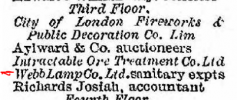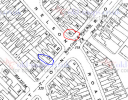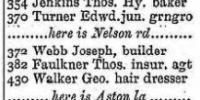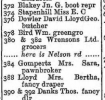-
Welcome to this forum . We are a worldwide group with a common interest in Birmingham and its history. While here, please follow a few simple rules. We ask that you respect other members, thank those who have helped you and please keep your contributions on-topic with the thread.
We do hope you enjoy your visit. BHF Admin Team -
HI folks the server that hosts the site completely died including the Hdd's and backups.
Luckily i create an offsite backup once a week! this has now been restored so we have lost a few days posts.
im still fixing things at the moment so bear with me and im still working on all images 90% are fine the others im working on now
we are now using a backup solution
You are using an out of date browser. It may not display this or other websites correctly.
You should upgrade or use an alternative browser.
You should upgrade or use an alternative browser.
JOSEPH WEBB...SEWER GAS LAMPS
- Thread starter Astoness
- Start date
Bob Davis
Bob Davis
This theme shows what BHF is all about, there is almost a Dickensian novel here, good work all of you for making some fascinating reading, by the way the page from the book that started the thread was also interesting, reading the column on the left hand side made me more curious. What was the book? More interesting where do we go from here, more please, no maps yet?
Bob
Bob
totally agree with you bob...this forum is a proper history forum..meant for like minded people to learn more about the history of birmingham and its people with members always willing to chip in...this is what sets us apart from other social media pages...you would be surprised at just how many members log in to trawl the thousands of threads we have on offer but actually never make a post and that is fine by us because as long as we are helping we are achieving our aim.... 
just going back to this thread...joseph webb was certainly an interesting man and although he didnt hail from brum he certainly started off here with his invention much like james watt and william murdoch who were not brummies but made their mark here so we adopted them...the great matthew boulton was however a brummie
thanks to everyone who has contributed to this thread...been a tad busy of late but later on i shall read it from the beginning
lyn
just going back to this thread...joseph webb was certainly an interesting man and although he didnt hail from brum he certainly started off here with his invention much like james watt and william murdoch who were not brummies but made their mark here so we adopted them...the great matthew boulton was however a brummie
thanks to everyone who has contributed to this thread...been a tad busy of late but later on i shall read it from the beginning
lyn
Pedrocut
Master Barmmie
This theme shows what BHF is all about, there is almost a Dickensian novel here, good work all of you for making some fascinating reading, by the way the page from the book that started the thread was also interesting, reading the column on the left hand side made me more curious. What was the book? More interesting where do we go from here, more please, no maps yet?
Bob
In the link quoted in the first post Nik Morton says, “At one time I was the World Authority on Webb Patent Gas Sewer Lamps.” Perhaps the BHF has added a bit more ?
There is a renumbering between the 1908 & 1910 Kellys. This seems to have been because, or largely because of, 12 new numbers being inserted between no 2 and no 40 0n that side of the road, at least 6 of these being previously listed as 2A,4A,6A, 8A.10A and 12A.I think there might have been a renumbering: Mike might know more.
1892 directory has 372 on the opposite side of Nelson Road from 370 but in the 1950s they were side by side.
View attachment 160544
Nelson Road is not in 1890 directory but is in 1892.
By 1940 the numbers have changed
View attachment 160545
pjmburns
master brummie
Must have been on forum too long today. Just twigged that if 12 numbers were inserted then 372 became 384 and so Joseph only had one house on Witton Road.There is a renumbering between the 1908 & 1910 Kellys. This seems to have been because, or largely because of, 12 new numbers being inserted between no 2 and no 40 0n that side of the road, at least 6 of these being previously listed as 2A,4A,6A, 8A.10A and 12A.
thats the maths teacher in you coming out janMust have been on forum too long today. Just twigged that if 12 numbers were inserted then 372 became 384 and so Joseph only had one house on Witton Road.
Been trying to get a picture as to how the lamps were set up and used. Were particular streets selected ? Did the gas come directly from the sewer into the lamp? Or was it stored ? Can’t help thinking that there surely wouldn’t be enough gas to light many streets. And I’d have thought it’s supply a tad unpredictable with respect to the volume of gas produced. So did some Birmingham streets have these lamps ? Viv.
Last edited:
Pedrocut
Master Barmmie
Pete’s post gives a good description…
Post in thread 'JOSEPH WEBB...SEWER GAS LAMPS'
https://birminghamhistory.co.uk/for...joseph-webb-sewer-gas-lamps.53877/post-736830
Post in thread 'JOSEPH WEBB...SEWER GAS LAMPS'
https://birminghamhistory.co.uk/for...joseph-webb-sewer-gas-lamps.53877/post-736830
Viv, these lamps were made to draw out the gases in the sewers by heat of the gas mantels burning. Serwer gas is quite explosive and dangerous.Been trying to get a picture as to how the lamps were set up and used. Were particular streets selected ? Did the gas come directly from the sewer into the lamp? Or was it stored ? Can’t help thinking that there surely wouldn’t be enough gas to light many streets. And I’d have thought it’s supply a tad unpredictable with respect to the volume of gas produced. So did some Birmingham streets have these lamps ? Viv.
They had there own gas supply that powered a ring of 6 to eight gas mantles. The gas was drawn up the hollow lamp column and out of a vent at the top. The maker claimed this also deodorised the smell too.
They were normally installed on higher ground and where sewer gas tended to collect. There was one at the bottom of Station Road and Gravelly Lane Erdington and another at the Chester Road End.
There are still lots of them in Sheffield and are Grade II listed
Thanks Pedro, missed that post. Interesting piece of history. Seems the lamps went far afield too; India, Singapore and Spain. I expect there’s more likelihood of finding some of the lamps still in these places.Pete’s post gives a good description…
Post in thread 'JOSEPH WEBB...SEWER GAS LAMPS'
https://birminghamhistory.co.uk/for...joseph-webb-sewer-gas-lamps.53877/post-736830
Thanks Mort. Presumably the Erdington ones are no longer there. Pity because not only were they functional but attractive pieces of street furniture. And especially the drawing of the one (for the patent?) in Pete’s attachment. Viv.





